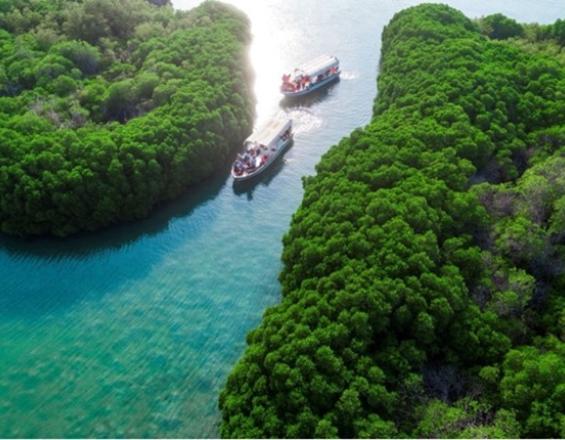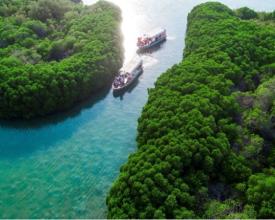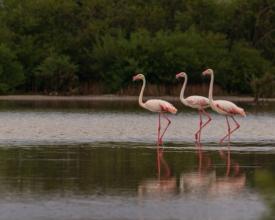Restoring and Conserving the Farasan Islands Protected Area: A Holistic Approach to Biodiversity Protection

The Farasan Archipelago, a unique terrestrial, coastal, and marine ecosystem in the southern Red Sea, has faced significant conservation challenges due to habitat degradation, unsustainable resource use, and invasive species spread. The Farasan islands protected area is home to the endemic Farasani gazelle (Gazella arabica farasani), diverse marine life, and critical blue carbon ecosystems. The National Centre for Wildlife (NCW) of Saudi Arabia implemented a comprehensive conservation program to address these threats. This included a biannual biodiversity monitoring plan, habitat restoration efforts, invasive species management, fisheries regulation, and enhanced law enforcement. The program has led to measurable conservation successes, including the stabilization and gradual increase of the Farasani gazelle population, improved coral reef and seagrass health, and heightened public awareness of biodiversity protection. The reserve now stands as a model for integrated conservation and balanced ecological sustainability.
Context
Challenges addressed
The Farasan Archipelago, a UNESCO Biosphere Reserve since 2021, is a complex of islands, coral reefs, seagrass meadows, and mangroves in the southern Red Sea. The Farasan Islands Protected Area, designated in 1988, spans 5,408 km² across 266 islands. Home to ~15,000 people, mainly fishers, it was first protected for the endemic Farasani gazelle (Gazella arabica farasani), distinct from the Arabian gazelle. Other terrestrial fauna include the white-tailed mongoose, three species of rodents, and four species of bats. A critical site for seabirds, it hosts 145 species, including pelicans and ospreys.
The marine ecosystem supports nesting hawksbill and green turtles, dugongs (vulnerable), and dolphins, including the Endangered Indian Ocean humpback dolphin. Sharks and rays, like whale sharks and mantas, are now protected. However, threats like urbanization, invasive species, overfishing, and coral degradation necessitate urgent conservation to sustain Farasan’s biodiversity.
Location
Process
Summary of the process
The National Centre for Wildlife (NCW) Saudi Arabia implemented a comprehensive threat restoration and conservation program in Farasan Island Protected Area encompassing an area of 5408 km2. To safeguard the wildlife species distributed on the Island, especially gazelle and water birds, NCW established a robust monitoring and patrolling system. This involved regular surveillance of the area, enforcement of anti-poaching laws, and the use of technology to track the movements and health of the animals. An invasive species management plan was also prepared and implemented as an effort to restore the natural habitat.
To reduce bycatch of sharks, rays, and reduce overfishing a specially designed Fisheries Management Plan was developed for the Reserve. To reduce adult turtle mortality, a Turtle Excluder Device (TED) program was developed. To reduce habitat fragmentation and destruction, a trawling zoning scheme was designed. Nesting site restorations were performed for turtles and seabirds on the islands. In addition, NCW aimed to re-establish the natural processes that had been disrupted by non-sustainable fishing practices and coastal debris. Measures were taken to restore the natural habitats and breeding grounds.
Building Blocks
Biodiversity monitoring
A biannual systematic monitoring plan was implemented, with terrestrial animals surveyed twice a year to assess population trends and threats in the protected area. Additionally, intensive studies were conducted to evaluate the area's terrestrial biodiversity. These studies provided valuable insights into ecological balance, species richness, and overall ecosystem health, documenting one bat species, one reptile species, and 11 invertebrate species as first records for Saudi Arabia.
During 2023 and 2024, extensive surveys of the Red Sea habitats (coral reefs, seagrass meadows, and mangroves), coral reef fishes, and marine mammals were conducted including the Farasan Islands. These studies provided valuable insights into the ecological balance, diversity, species richness, and overall health of the coral reef and associated habitats. Previous nesting turtle monitoring studies have also provided valuable information on Farasan turtle populations.
Habitat restoration
Preventing the destruction of coral formations, seagrass meadows, and mangroves, are measures to restore these natural habitats. Cleaning and restoring nesting sites for seabirds and turtles prevent population decline and restore coastal vegetation that prevents erosion. Habitat degradation resulting from coastal development activities is being effectively mitigated in the reserve through strategic measures aimed at controlling human impacts and enforcing regulations pertaining to fishing activities.
To restore the ecosystem's structure, function, and biodiversity, collaborative efforts with the Saudi Fisheries Authority and fishermen have facilitated conservation efforts.
Invasive species management
Invasive species management plan was prepared and implemented to deal with invasive birds as well as invasive plant species on the Island. Important invasive bird species on Farasan include Common myna Acridotheres tristis and House Crow Corvus splendens. Invasive plants found on Farasan Island include Mesquite Prosopis juliflora and Jerusalem thorn Parkinsonia aculeata. Mitigation efforts are planned to be scaled up after the evidence of initial success.
Law enforcement
The NCW, in collaboration with local authorities, has implemented environmental regulations and established protected habitats to ensure the safety and sustainability of wildlife. These include a ban on hunting and the designation of protected zones. Measures have also been taken to prevent the collisions of birds with high-voltage power lines.
Impacts
Conservation efforts in the Farasan Islands Protected Area have delivered significant ecological, scientific, and social benefits. These interventions emphasize habitat restoration, sustainable fishing, and biodiversity protection.
- Monitoring & Adaptive Management: Continuous assessments of terrestrial biodiversity, including the Farasani gazelle, inform data-driven decisions. Fisheries monitoring and biodiversity tracking enable dynamic conservation adjustments to maintain ecosystem health.
- Restoring Ecological Functions: Protecting habitats and species supports the interdependence of coral reefs, seagrasses, and mangroves, essential for sustaining marine biodiversity.
- Conservation Awareness: Public engagement has grown as habitat recovery highlights the importance of biodiversity protection.
- Invasive Species Management: Regular surveillance, early detection, and removal strategies have reduced invasive species. An integrated plan cut the House crow population by 70%, benefiting native wildlife.
- Law Enforcement & Compliance: Strong patrols, surveillance, and local collaboration curb poaching, illegal fishing, and habitat destruction. These efforts have stabilized and gradually increased the Farasani gazelle population and helped in conservation of other important terrestrial and marine species.
Beneficiaries
- Habitats: Islands, Coral reefs, Seagrasses, Mangroves
- Species: Farasani gazelle, Hawkbill and Green turtles, Shark and Rays, Seabirds, Coral Reef Fishes, Marine mammals
- Local Communities

